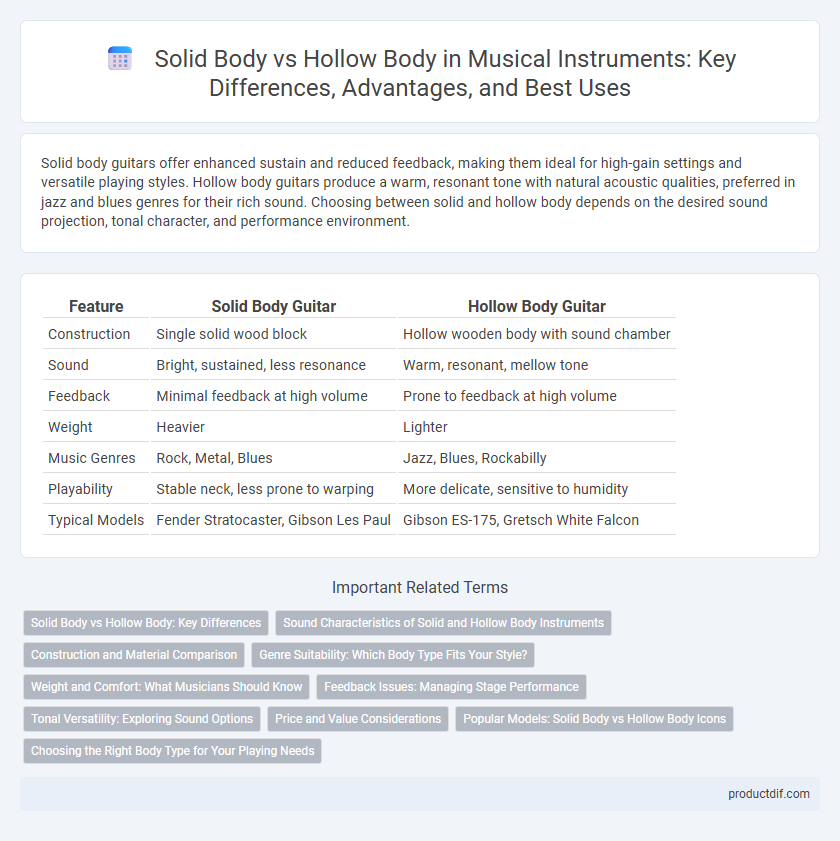Solid body guitars offer enhanced sustain and reduced feedback, making them ideal for high-gain settings and versatile playing styles. Hollow body guitars produce a warm, resonant tone with natural acoustic qualities, preferred in jazz and blues genres for their rich sound. Choosing between solid and hollow body depends on the desired sound projection, tonal character, and performance environment.
Table of Comparison
| Feature | Solid Body Guitar | Hollow Body Guitar |
|---|---|---|
| Construction | Single solid wood block | Hollow wooden body with sound chamber |
| Sound | Bright, sustained, less resonance | Warm, resonant, mellow tone |
| Feedback | Minimal feedback at high volume | Prone to feedback at high volume |
| Weight | Heavier | Lighter |
| Music Genres | Rock, Metal, Blues | Jazz, Blues, Rockabilly |
| Playability | Stable neck, less prone to warping | More delicate, sensitive to humidity |
| Typical Models | Fender Stratocaster, Gibson Les Paul | Gibson ES-175, Gretsch White Falcon |
Solid Body vs Hollow Body: Key Differences
Solid body guitars feature a dense, non-resonant wooden core that minimizes feedback and enhances sustain, making them ideal for high-gain amplification and versatile music styles. Hollow body guitars possess a resonant chamber that produces a warm, rich tone with natural acoustic qualities but are more prone to feedback at high volumes. The choice between solid and hollow bodies impacts tonal characteristics, playability, and suitability for genres such as rock, jazz, and blues.
Sound Characteristics of Solid and Hollow Body Instruments
Solid body instruments produce a focused, sustained sound with minimal feedback, making them ideal for genres requiring strong, clear tones like rock and metal. Hollow body instruments offer a warm, resonant sound with rich overtones and natural acoustic qualities, favored in jazz and blues for their depth and tonal complexity. The choice between solid and hollow bodies significantly influences the instrument's resonance, feedback response, and tonal warmth.
Construction and Material Comparison
Solid body guitars feature a dense, solid wood construction typically made from mahogany, alder, or ash, providing enhanced sustain and reduced feedback. Hollow body guitars utilize a resonant chamber crafted from laminated maple or spruce, offering rich acoustic tones but increased susceptibility to feedback at high volumes. The choice of construction material directly influences tonal characteristics, weight, and playability, with solid bodies favoring electric clarity and hollow bodies emphasizing warmth and resonance.
Genre Suitability: Which Body Type Fits Your Style?
Solid body guitars excel in genres like rock, metal, and punk due to their resistance to feedback and ability to sustain high gain tones. Hollow body guitars are ideal for jazz, blues, and classic rock, offering warm, resonant tones with richer acoustic properties and enhanced resonance. Choosing between solid and hollow body depends largely on desired sound characteristics and the specific demands of your musical style.
Weight and Comfort: What Musicians Should Know
Solid body guitars typically weigh more due to dense wood construction, offering enhanced sustain but potentially causing fatigue during long performances; hollow body guitars are lighter, providing increased comfort and easier handling. Musicians prioritizing comfort for extended play often prefer hollow body models, while those seeking tonal depth may accept added weight from solid bodies. Weight distribution also varies, influencing overall balance and player endurance in different musical settings.
Feedback Issues: Managing Stage Performance
Solid body guitars are less prone to feedback issues during stage performances due to their dense construction that minimizes sound resonance. Hollow body guitars, while offering warmer tones, often experience increased feedback at high volumes because of their resonant chambers amplifying unwanted noise. Musicians frequently use feedback suppressors or adjust amplifier settings to manage these challenges effectively.
Tonal Versatility: Exploring Sound Options
Solid body guitars deliver a focused, sustained tone ideal for rock and metal genres, minimizing feedback with high gain settings. Hollow body guitars provide rich, warm resonance suited for jazz and blues, offering natural acoustic projection and complex harmonic overtones. Musicians seeking tonal versatility often combine solid and hollow elements to balance sustain, clarity, and dynamic range across diverse playing styles.
Price and Value Considerations
Solid body guitars typically offer greater durability and lower feedback at higher volumes, often available at a more affordable price point than hollow body models, making them a practical choice for beginners and budget-conscious players. Hollow body guitars, while generally more expensive due to their craftsmanship and materials, provide rich, resonant tones favored in jazz and blues, delivering higher value for artists prioritizing sound quality and aesthetic appeal. Evaluating price against performance and musical style helps buyers determine the best investment between solid and hollow body instruments.
Popular Models: Solid Body vs Hollow Body Icons
Fender Stratocaster and Gibson Les Paul dominate the solid body guitar market with their sleek designs and versatile sound suited for rock and blues. In contrast, hollow body models like the Gibson ES-175 and Gretsch White Falcon appeal to jazz and rockabilly players, prized for their warm, resonant tones and vintage aesthetics. These iconic instruments shape the distinct sonic landscapes of their genres, influencing playing styles and recording techniques worldwide.
Choosing the Right Body Type for Your Playing Needs
Solid body guitars provide enhanced sustain and reduced feedback, making them ideal for high-gain environments and precise sound control. Hollow body guitars offer a warmer, resonant tone with natural acoustic qualities, suited for jazz, blues, and clean settings. Selecting the right body type depends on your preferred music style, playing environment, and tonal preference to achieve optimal performance.
solid body vs hollow body Infographic

 productdif.com
productdif.com